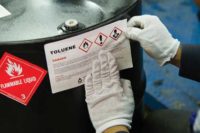
According to OSHA, 61 million Americans have cardiovascular disease. The result of this epidemic is approximately one million deaths per year with up to 400,000 of these deaths due to cardiac arrest. The good news? The sooner defibrillation is started, the more likely the victim will survive.
If you are thinking of purchasing or already have purchased AEDs (automated external defibrillators) for your workplace, you must develop a written program to effectively manage the AEDs. As with any written workplace safety program, yours should address all aspects of the equipment, including state laws related to purchasing, physician oversight, employee training, use, maintenance, and recordkeeping.
Must you have an AED?
Some states require that public access buildings, gyms, exercise facilities, schools, and day care operations have AEDs. OSHA recommends, but does not require, that you have an AED in the workplace and puts the onus for the decision onto the employer and the medical professional. (See Sidebar: “OSHA says...”)
Purchase
If state law requires one or more AEDs on your premises, or if there are any laws which affect purchase of an AED, those laws should be referenced in your written program. OSHA says that an employer should consider making AEDs available if:
- Many people work closely together (e.g., assembly lines, office buildings)
- Confined spaces are present
- Electric-powered devices are used
- Lightning may occur at outdoor worksites
- Workers may seek treatment for heart attack symptoms
- Fitness units and cafeterias are located on-site
- Companies operate remote sites (e.g., off-shore drilling rigs, construction projects, marine vessels, power transmission lines and energy pipe lines)
When deciding upon the number of AEDs and their placement, keep in mind that prompt treatment — 3 to 5 minutes after the onset of cardiac arrest — is recommended. Responders should be able to reach the victim, make an assessment, and begin treatment within that time frame.
Responsibility
The written program should identify the individual who has overall responsibility for your AED program. Having one individual in charge makes it easier to ensure that maintenance schedules are followed, required training is completed, and AED inspections and testing are carried out per manufacturer recommendations.
Physician oversight
Some state laws require physician oversight of your AED program. In addition to providing the prescription to purchase the AED, a physician can offer guidance on the number of AEDs needed, their distribution, user training, and the development of an emergency response plan. This information and any other suggestions should be included in the written program.
Training
The written program should include detailed training requirements for those who use the AEDs. AED training is inexpensive and readily available from a variety of sources such as The American Red Cross and The American Heart Association, among others. AED training can usually just be added to the cardiopulmonary resuscitation (CPR) classes that workplace emergency responders receive.
OSHA suggests that employees responding to an emergency be trained to:
- Recognize sudden cardiac arrest and notify EMS personnel Perform CPR
- Provide early defibrillation with an AED
- Care for the victim until EMS personnel arrive
Use
The written program should spell out who is authorized to use the AEDs. If it is only trained members of your workplace emergency response team, the program should state this. If you will allow anyone who is trained and certified to use the AEDs, the program should state as much.
Maintenance
AEDs must receive regular and proper inspection, service and maintenance to ensure proper functioning. Your supplier and the AED’s written instructions will provide this information. Once the unit is used, service is always required. Periodic self-diagnostic tests and regular battery replacement, as recommended by the manufacturer, will help ensure that when the unit is needed, it will operate as designed.
Designated persons at your facility should be responsible for inspection, service, and maintenance on a regular basis. The written program should include a description of all required maintenance including how often it is done, and who is responsible for seeing that it is properly carried out.
Recordkeeping
AED service records should be part of the written program. It is important to keep a written record of each individual AED in your facility in case you are ever asked to produce information regarding tests and maintenance done to the unit. You should note each time the unit was used and what maintenance was performed following use. Also, record when pads and batteries have been replaced (reference the manufacturer’s recommended maintenance schedule).
A written program
Purchasing and installing AEDs in your workplace helps prevent deaths from sudden cardiac arrest. But it is only the first step in the process. Developing a written program that addresses responsibilities, training, use, maintenance, and recordkeeping will ensure that the most appropriate help is available to those who may require it in an emergency situation.
SIDEBAR: OSHA says…
In an OSHA Letter of Interpretation (LOI) dated 06/17/2004, the agency states “The Medical Services and First Aid Standard, 29 CFR 1910.151…does not specifically require that AEDs be included in first aid supplies.…It is the responsibility of the employer to make an assessment of the workplace and all first aid needs for expected injuries and illnesses.”In other words, OSHA puts the onus for the decision to have an AED onto the employer and the medical professional. In Technical Information Bulletin 01-12-17, OSHA suggests that employers “consider the use of AEDs at their worksite to reduce the time to defibrillation with the goal of improving survival.”
OSHA has said in a LOI that employees trained in CPR and AED don’t necessarily fall under the bloodborne pathogens standard unless these employees also have “occupational exposure” to blood or other potentially infectious material. If you require those who will use the AED to complete bloodborne pathogens training and receive the hepatitis B vaccinations, then you should include details of this type of training in the written program as well.

